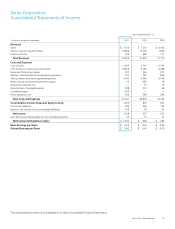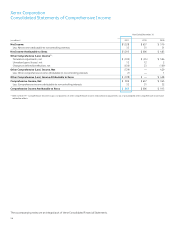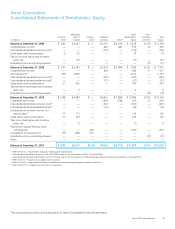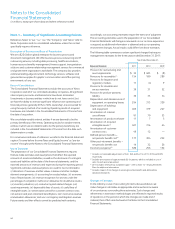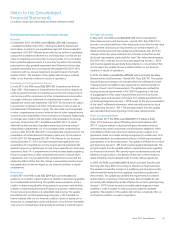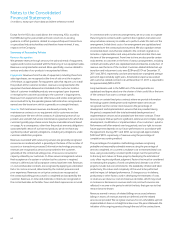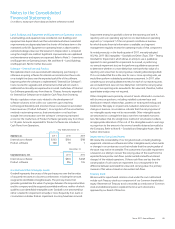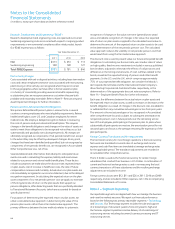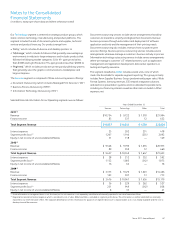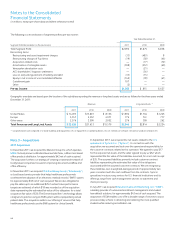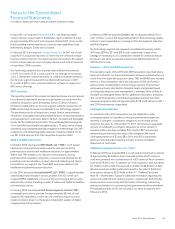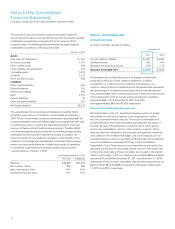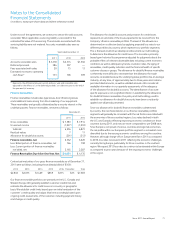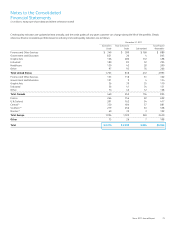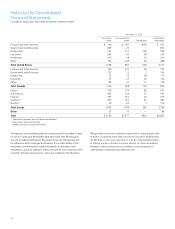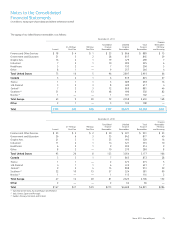Xerox 2011 Annual Report Download - page 67
Download and view the complete annual report
Please find page 67 of the 2011 Xerox annual report below. You can navigate through the pages in the report by either clicking on the pages listed below, or by using the keyword search tool below to find specific information within the annual report.
65Xerox 2011 Annual Report
Impairment testing for goodwill is done at the reporting unit level. A
reporting unit is an operating segment or one level below an operating
segment (a “component”) if the component constitutes a business
for which discrete financial information is available, and segment
management regularly reviews the operating results of that component.
As noted previously, in the fourth quarter of 2011, we early-adopted
ASU No. 2011-08, Intangibles – Goodwill and Other (Topic 350) – Testing
Goodwill for Impairment, which allows an entity to use a qualitative
approach to test goodwill for impairment. As a result, in performing
our annual impairment test, we first perform a qualitative assessment
to determine whether it is more likely than not that the fair value of a
reporting unit is less than its carrying value, including allocated goodwill.
If it is concluded that this is the case for one or more reporting units, we
would then perform a detailed quantitative assessment. In 2011, after
completing our annual qualitative reviews for each of our reporting units,
we concluded that it was not more likely than not that the carrying value
of any of our reporting units exceeded its fair value and, therefore, further
quantitative analysis was not required.
Other intangible assets primarily consist of assets obtained in connection
with business acquisitions, including installed customer base and
distribution network relationships, patents on existing technology and
trademarks. We apply an impairment evaluation whenever events or
changes in business circumstances indicate that the carrying value of
our intangible assets may not be recoverable. Other intangible assets
are amortized on a straight-line basis over their estimated economic
lives. We believe that the straight-line method of amortization reflects
an appropriate allocation of the cost of the intangible assets to earnings
in proportion to the amount of economic benefits obtained annually by
the Company. Refer to Note 8 – Goodwill and Intangible Assets, Net for
further information.
ImpairmentofLong-LivedAssets
We review the recoverability of our long-lived assets, including buildings,
equipment, internal use software and other intangible assets, when events
or changes in circumstances occur that indicate that the carrying value of
the asset may not be recoverable. The assessment of possible impairment
is based on our ability to recover the carrying value of the asset from the
expected future pre-tax cash flows (undiscounted and without interest
charges) of the related operations. If these cash flows are less than the
carrying value of such asset, an impairment loss is recognized for the
difference between estimated fair value and carrying value. Our primary
measure of fair value is based on discounted cash flows.
TreasuryStock
We account for repurchased common stock under the cost method and
include such Treasury stock as a component of our Common shareholders’
equity. Retirement of Treasury stock is recorded as a reduction of Common
stock and Additional paid-in capital at the time such retirement is
approved by our Board of Directors.
Land,BuildingsandEquipmentandEquipmentonOperatingLeases
Land, buildings and equipment are recorded at cost. Buildings and
equipment are depreciated over their estimated useful lives. Leasehold
improvements are depreciated over the shorter of the lease term or the
estimated useful life. Equipment on operating leases is depreciated to
estimated salvage value over the lease term. Depreciation is computed
using the straight-line method. Significant improvements are capitalized
and maintenance and repairs are expensed. Refer to Note 5 – Inventories
and Equipment on Operating Leases, Net and Note 6 – Land, Buildings
and Equipment, Net for further discussion.
Software–InternalUseandProduct
We capitalize direct costs associated with developing, purchasing or
otherwise acquiring software for internal use and amortize these costs
on a straight-line basis over the expected useful life of the software,
beginning when the software is implemented (“Internal Use Software”).
Costs incurred for upgrades and enhancements that will not result in
additional functionality are expensed as incurred. Useful lives of Internal
Use Software generally vary from three to 10 years. Amounts expended
for Internal Use Software are included in Cash Flows from Investing.
We also capitalize certain costs related to the development of
software solutions to be sold to our customers upon reaching
technological feasibility and amortize these costs based on estimated
future revenues (“Product Software”). In recognition of the uncertainties
involved in estimating revenue, that amortization is not less than
straight-line amortization over the software’s remaining estimated
economic life. Useful lives of Product Software generally vary from three
to 10 years. Amounts expended for Product Software are included in
Cash Flows from Operations.
Year Ended December 31,
Additions to: 2011 2010 2009
Internal use software $ 163 $ 164 $ 98
Product software 108 70 1
December 31,
Capitalized costs, net: 2011 2010
Internal use software $ 545 $ 468
Product software 256 145
GoodwillandOtherIntangibleAssets
Goodwill represents the excess of the purchase price over the fair value
of acquired net assets in a business combination, including the amount
assigned to identifiable intangible assets. The primary drivers that
generate goodwill are the value of synergies between the acquired entities
and the company and the acquired assembled workforce, neither of which
qualifies as an identifiable intangible asset. Goodwill is not amortized but
rather is tested for impairment annually or more frequently if an event or
circumstance indicates that an impairment loss may have been incurred.
Notes to the Consolidated
Financial Statements
(in millions, except per-share data and where otherwise noted)


